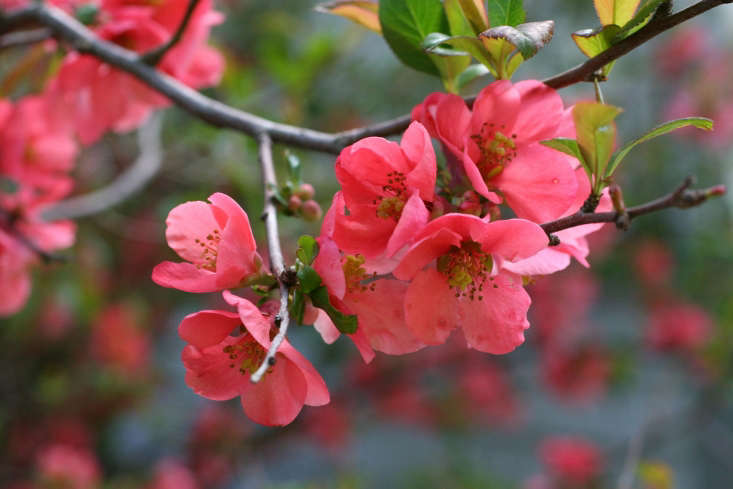Flowering Quince, Chaenomeles speciosa: “Hint of Spring”
A few blocks from my house in Brooklyn there is a flowering quince in the tiny front yard of a stately brownstone. One day recently I passed by and was surprised to notice that it had already begun its early spring flower show. The shrub’s stark thicket of brown-black branches are now festooned with adorable cup shaped flowers in an eye-popping shade of bright orangey pink. Seemingly overnight this Asian native had transformed itself from a bare, unremarkable shrub to a decorative ornament worthy of its place of honor at the entrance to an elegant home.

Chaenomeles speciosa is an extremely early spring bloomer by nature but our record-breaking warm February temperatures here in the Northeast seem to have gotten it going even sooner than usual. Some garden designers tend to compare this plant to Forsythia, which also flowers in late winter to early spring on bare wood. They dismiss it as a plant that is only interesting when it blooms, after which it blends into the background for the rest of the year. But they seem to underestimate flowering quince, forgetting that its show is far from over when its delicate pink, red or white flowers fade in a couple of weeks or so.

In summer, after it leafs out, this plant produces a crop of highly aromatic greenish yellow pomes that resemble midget asian pears. They are quite attractive and definitely add interest, but these fruits are so hard and bitter that they cannot be eaten out of hand. It’s important to note that the fruit of Chaenomeles speciosa is not to be confused with the larger and more readily consumed fruit of the quince tree (Cydonia oblonga) which is related to flowering quince but is a completely different plant. Fruits from the flowering quince plant are edible but only as cooked ingredients in jams and jellies.

Cheat Sheet
- Flowering quince has significant thorns so it is best positioned away from high traffic areas where it could easily cause injury to passers-by.
- Plant a row of these for an impenetrable hedge that can function as a security barrier and also as a safe haven for the nests of song birds.
- Flowering quince is quite attractive as an espalier on a wall or fence and has traditionally been used in Japan for bonsai.
- Extend the rather brief bloom time by cutting branches with buds and bringing them indoors to force into flower.
Keep It Alive
- Flowering quince is hardy in zones 4 to 9 and will grow in full sun to partial shade, although it flowers best in full sun.
- It is tolerant of most kinds of soil, even clay, as long as they are well draining but prefers to grow in earth that is at least somewhat acidic.
- Exposed sites, such as terraces on high floors and roof decks, where strong winds are a danger should be avoided as wind can damage the plant by snapping branches. Otherwise this plant is a good candidate for a city garden as, once established, it is very tolerant of poor soil, drought and urban pollution.

In general flowering quince is a tough and undemanding plant to grow, but it does need regular and proper pruning to maintain an attractive form. This plant can easily descend into an unsightly knotty looking mess if an annual pruning routine is neglected. It flowers on old wood so plan to prune in late spring after the blooms have faded. Identify the oldest stems and cut a third of them back to the ground. Remove any weak, dead or damaged stems and crossed branches. It is also good to take out some interior branches to allow good air circulation and light in the center of the plant, giving your flowering quince a head start on next year’s flower display.

Chaenomeles speciosa is known for its longevity and also for its large size… it can easily reach 10′ high by 10 ‘wide. If you are considering adding this plant to your garden make sure you have a spot that can accommodate it when it reaches maturity. If your garden is small you might want to consider one of the many cultivars bred to be smaller such as “Cameo” which has frilly coral blooms and tops out at 5′ or “Texas Scarlet” which is a 3′ high by 5’ wide dwarf with bright red flowers that has the added advantage of being almost thornless. According to the eminent reference “Dirr’s Hardy Trees and Shrubs” there are literally hundreds of varieties to choose from. You are sure to find the perfect one for your garden.
See more tips for growing flowering quince in our design guide to Flowering Quince 101. And browse our Shrubs archives for garden design ideas, and see more of our favorite flowering shrubs:








Have a Question or Comment About This Post?
Join the conversation